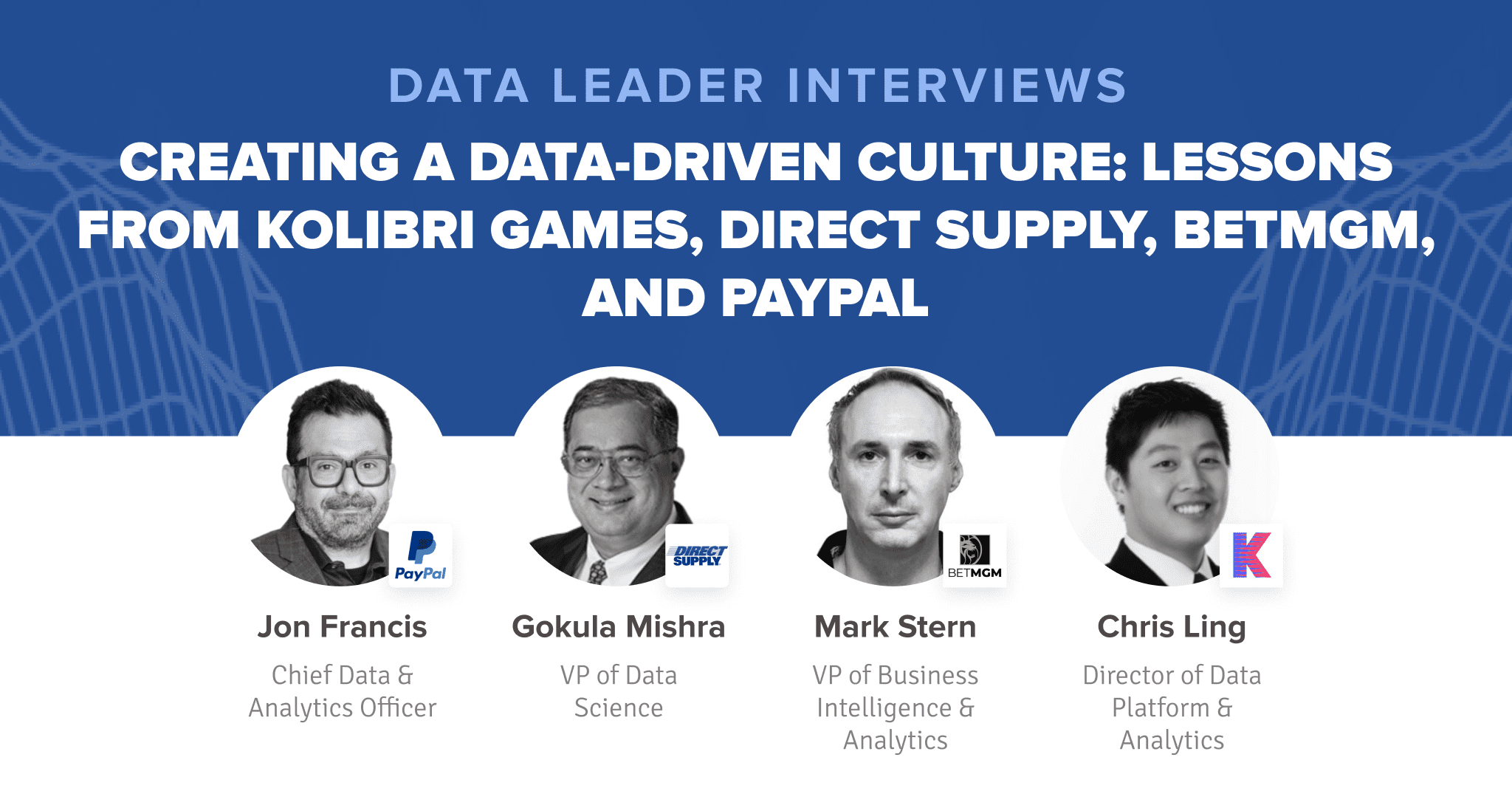March 15, 2022
Data Leader Interviews: Lessons from Leaders at Bank of America, Hanover Insurance Group, Rockwell Automation and SAP
During another round of interviews with data leaders, I spoke with several industry experts about creating and fostering a data-driven culture. We discussed different data architectures, the gap between data produced and data consumed, data literacy, and more.
The data experts I spoke to included: Chris Ling, Director of Data Platform and Analytics at Kolibri Games; Gokula Mishra, VP of Data Science at Direct Supply; Mark Stern, VP of Business Intelligence and Analytics at BetMGM; and Jon Francis, Chief Data and Analytics Officer at PayPal.
Continue reading to learn more about how to create and foster a data-driven culture.
What do you think about Data Lakehouses vs. Data Warehouses?
“It’s important to remember that no technology is adopted at exactly the same time,” stated Chris Ling from Kolibri Games. While his company had a data lake already, they couldn’t create enough value from the data stored there. Ling’s team found that moving to a lakehouse approach solved this usability problem, so new technologies can be adopted over time to overcome new challenges.
According to Ling, data lakehouses and data warehouses complement each other. Data lakehouses are great for working with data stored in a data lake and data warehouses are great for analysis workloads. He recommends implementing both options so that data consumers can use the best tool for the job.
Why is there such a big gap between data produced and data used?
Gokula Mishra of Direct Supply believes business systems are producing the most data internally at enterprises along with a lot of external data collected from partners and customers. The problem is that much of this data goes underutilized at many organizations.
“Unless we ask more questions of the data beyond what happened, we won’t be looking for the right data to answer more complex questions,” Mishra explained. “Data usage is driven by the variety of questions that a business is asking.”
Organizations really don’t need a lot of data for descriptive and diagnostic analytics, according to Mishra, but when you move towards predicting the future you need to use much more data. When organizations improve their data maturity, therefore, they’ll begin to close the gap on underutilized data and make better use of the data they collect for data-driven decisions.
How does data literacy impact creating a data-driven culture?
“Data literacy is incredibly important,” stated Mark Stern from BetMGM. “You can spend fortunes on your technology and still make very little progress on improving decision-making and monetizing data.” That’s why a large part of Stern’s role is helping people understand the data.
Stern also says there’s a “gut feel” when it comes to decision-making, especially when there’s no relevant data to use. But relying on human reasoning alone, he says, isn’t a scalable solution. He believes it’s best to combine gut feel with data analytics. Through data literacy training, organizations can expand their data analytics user base and help more employees interpret data effectively to make better business decisions.
What are some of the key capabilities for data analytics?
According to Jon Francis from PayPal, it’s important to get comfortable with using cloud-based technologies. “The real power is in being able to scale easily and thinking about leveraging cloud capabilities,” Francis said. “Whether it’s using Azure, GCP, or AWS, having familiarity and being comfortable with those platforms is critical.”
More broadly, Francis thinks it’s crucial to have skills around the productization of analytics. “We have a tendency in analytics to treat each problem set as unique and to bring resources together in an ad hoc way to solve problems,” he concluded, “But more and more, we should be thinking like product owners and about how we can scale the solutions we’re building.”
In the end, it’s vital to build a data-driven culture through data literacy and training, but there will never be enough humans to solve every problem. The right data architecture is the key to scaling data-driven decision-making at today’s enterprises.
You can watch the full discussion I had with these data leaders about How to Create and Foster a Data-Driven Culture. In addition, we put together an eBook about how to Make AI & BI Work at Scale with 15 thought leaders and experts in the data industry about scaling AI and BI at large organizations.


The Practical Guide to Using a Semantic Layer for Data & Analytics